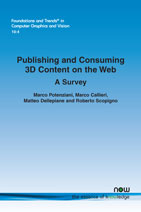Publishing and Consuming 3D Content on the Web: A Survey
By Marco Potenziani, Visual Computing Lab, ISTI CNR, Italy, marco.potenziani@isti.cnr.it | Marco Callieri, Visual Computing Lab, ISTI CNR, Italy, marco.callieri@isti.cnr.it | Matteo Dellepiane, Visual Computing Lab, ISTI CNR, Italy, matteo.dellepiane@isti.cnr.it | Roberto Scopigno, Visual Computing Lab, ISTI CNR, Italy, roberto.scopigno@isti.cnr.it
Abstract
Three-dimensional content is becoming an important component of the World Wide Web environment. From the advent of WebGL to the present, a wide number of solutions have been developed (including libraries, middleware, and applications), encouraging the establishment of 3D data as online media of practical use. The fast development of 3D technologies and related web-based resources makes it difficult to identify and properly understand the current trends and open issues. Starting from these premises, this survey analyzes the state of the art of 3D web publishing, reviews the possibilities provided by the major current approaches, proposes a categorization of the features supported by existing solutions, and cross-maps these with the requirements of a few main application domains. The results of this analysis should help in defining the technical characteristics needed to build efficient and effective 3D data presentation, taking into account the application contexts.
Publishing and Consuming 3D Content on the Web: A Survey
Recently tools such as 3D printing, 3D viewers, and editing systems embedded in common operating systems have seen 3D data evolve from specialized content, used by a few professionals, to completely integrated web content used by many internet users. These new trends are pushing 3D content towards ubiquitous use, whereby data management, user interactions, and crossmedia integration are open issues still to be solved.
The growth in widely available tools for 3D web content has given rise to complicated situations for those developers and users with a poor awareness of the peculiar needs of each specific combination of 3D data and application domain requirements.
This monograph presents a comprehensive survey of the currently available Web3D tools and their applications. The authors define a schema of the available possibilities and features supported by enabling technologies and implemented systems. This results in providing a roadmap that, depending on the application field, navigates the user through the technical characteristics needed to build an efficient and effective Web3D presentation.
Publishing and Consuming 3D Content on the Web will be of interest to all readers wishing to master the concepts which characterize the different phases of the Web3D publishing process.
